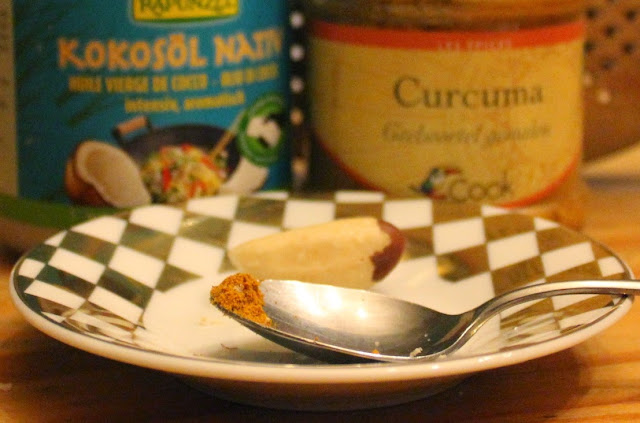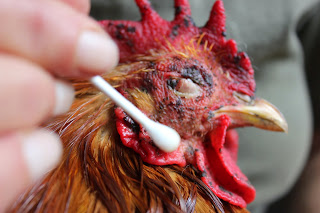Here's Drusilla she is one of my coturnix quail and over the past few days she has started to limp, holding up her foot and hopping about, or moving by flying from a to b, usually towards the food bowl! (If you have an injured bird who, unlike Drusilla, is exhibiting signs of stress and has obvious lesions and thus needs immediate emergency treatment scroll down to the end of this article where you will find links to my other posts on these specific problems.)
Trying to establish what and where
The first thing I did was try to ascertain where the problem was. There was no visible sign of injury, she was showing no evidence of pain and she was still eating well. Quail are very energetic birds and given the space will spend a great deal of the day moving about foraging. In particular because my quail are in a greenhouse, they have plenty of flying space so its something they practice on a daily basis. Unfortunately we have had quite a few electric storms lately and I think Drusilla may have flown up in surprise and landed badly.
I noticed the way she was holding her foot, occasionally with the toes spread out (left) but mostly held together and slightly curled. She seemed able to lift her foot from the ground but had no definite control over her foot. I presumed this was therefore nerve damage, a strain or sprain and that the problem was located below the knee and probably within the foot itself.
I felt gently all along the foot but I could feel nothing untoward although I am aware that the bones of the foot in this size of bird are obviously quite small and thus difficult to ascertain if any were broken. However, I do believe that if bone(s) had been broken Drusilla would have exhibited pain and/or there would have been some very obvious swelling, where the body would be protecting the injury. I therefore concluded that this was either nerve damage or a deficiency of a micro-nutrient prior to or following on from a possible accident.
Treatment - Nervous System Support
My first idea therefore, was to treat with nutritional support. B complex vitamins, from invertebrates from one of our many compost bins and a good supply of leafy green vegetables to cover B9 (folate). Folate works in synergy with the cobalamin (B12, from the invertebrate protein) and is of tantamount importance in maintaining nerve and motor function. I also added some yeast flakes to cover additional riboflavin (B2) support, in case a deficiency in this, was at the root of the problem. I did not actually believe this to be the case, as she has been on a good diet but B complex vitamins are water soluble so any excess would be excreted and I was not feeding huge amounts. I also have great faith in my birds' ability to know if and what they are lacking. I have seen so much evidence to support this hypothesis over the years. Furthermore, invertebrates such as earwigs and woodlice (sow bugs) are a valuable source of the amino-acid methionine, again a powerful nervous system support.
Treatment - Nervous System Repair
One of my favourite medicinal foods has to be turmeric and a couple of years back I began to grow it myself, as I believe it is even more potent when fresh, grown in quality organic soil and also just because it is a great plant to grow. If like me, you are living in a cold climate then you might like to share some of my tips and strategies for the culture of this fabulous medicinal and culinary vegetable and save yourself some money on organic turmeric at the same time.
I will include my film below and a future post will be dedicated to this and some of my other favourite medicinal plants. In Drusilla's case, I am using turmeric's active ingredient curcumin for nerve regeneration and functional recovery. This spice has so long been associated in humans with the treatment of Alzheimer's, Parkinson's, ADHD, Autism, ME, Bipolar Disorder, Down Syndrome... and of course for its other activities as a modulator of genetic activity and expression, in the treatment of cancer. There is a volume of research out there both ancient and modern for anyone wishing to follow this up. The problem with turmeric when taken in raw form is bioavailability, which for humans is only one percent of the available amount of curcumin. However, this is greatly improved when the turmeric, which is lipophilic or fat-loving, is taken in conjunction with a quality and therapeutic carrier oil like coconut.
I didn't actually know this until recently but I have always used these two together when treating my birds and have had amazing results with paralysis due to shock/stress. For added nervous and motor function support I also include a few gratings of Brazil nut in the mix. Brazil nuts contain a high level of selenium, approximately 50 micrograms per nut which is just under the human RDA. It should also be noted, when giving this powerful antioxidant to a bird, that selenium is toxic in large quantities, in fact humans are only supposed to consume 1 to 2 nuts per day, although selenium levels in specific nuts vary as to the quality of the growing medium. Hence my tendency towards caution with just a few gratings. What amazes me, is that all these remedies have been used for centuries and often through cookery, which takes us right back to Hippocrates and his holistic approach to food and medicine.
Calcium
As with any problem which involves the loss of movement in the legs, coupled with the fact that Drusilla has been laying clutches of eggs throughout the Spring and Summer, I also wondered about a calcium deficiency. As with humans, one should be very careful when supplementing calcium, as the way in which calcium is deposited in the body is dependent on balance, i.e. the ratio of Calcium to other minerals and vitamins in the diet. Without getting these right the calcium ends up in the soft tissue, not driven to the bone and thus in the bird's case, from there to the shell. The former, known as calcification, can end up causing various health problems including congestive heart failure. To this end I feed my birds separately with crushed oyster shell, thus they can identify it as such. Wild birds take in snail shells for calcium as indeed my hens will. Letting your bird regulate its own system is I believe, vitally important for getting to the root of any deficiency problem. Drusilla did indeed eat a little crushed shell but as the limp has never developed into anything else I do not believe this is a major concern. I would again like to expand on the calcium question, in a later post.
Treatments for stress and wounds
Neither of the following were necessary
in Drusilla's case but if you have a bird showing signs of stress,
grazing and broken skin, then the these should be treated immediately
and unless you need to stop bleeding - treat the stress first.
Stress due to injury
Stress is a potential
killer, so it's important to treat it quickly, in particular if
concurrent with any kind of injury. Your bird's system needs to be
functioning at optimum to deal with both the physical trauma of the
wound and the potential for any kind of infection. This most effective emergency treatment is concocted from foodstuffs
you probably already have to hand... read more.
Be aware that birds suffer badly from stress and unless you are sure your bird is not in shock, it is best to treat. Any injury or event, such as predator attack may cause the bird to go into shock and it is very likely to prove fatal if not treated within 24 hours.
Healing cuts and wounds - antiseptic wash, painkiller
This is a wash I make from two essential oils and which I have used with great success both on my birds and myself when I stupidly cut across my knuckle with a sickle last year. It is also great for healing - I have no scar! My main use for it with my poultry however, has been on the rare occasions two of my cockerels/roosters have got into a bust up...read more
In the next part of this article I will look at how to further treat Drusilla with a cabbage poultice, (live link below) this is a very ancient remedy and based upon the active ingredients of the cabbage which include anti-inflammatory polyphenols.
In the meantime here's my film on growing turmeric and ginger and providing yourself with a permanent stock of these two invaluable therapeutic and culinary plants.
Thanks
for dropping by and if you have enjoyed this
piece and found it
useful think about sharing it with your family and friends, on social
media and also maybe about joining this blog
and/or subscribing to my Youtube channel or even supporting us on
Patreon or
Sue
RELATED POSTS
Treating inflammation and infection in quail and chickens with a cabbage poultice.. follow this live link to read more
RETURN TO CONTENTS PAGE
© 2014 Sue Cross












